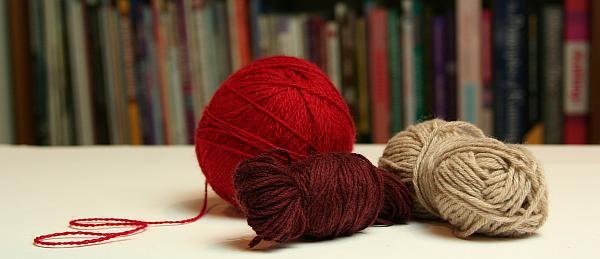
Cashmere comes from the downy undercoat of goats. While there isn't a particular breed of "cashmere goat", it's not the case that the down from any old goat is cashmere! With a diverse range of cashmere yarns on the market, I wanted to see if I could find ways to identify a yarn which would wash and wear well - before I spend any money on it.
Assessing the yarns
I had three yarns to try - Bergère de France Cachemire+, Jaeger Cashmina and Lotus Yarns Cashmere Fingering. There are more expensive yarns on the market, but my funds were limited! For price comparison, the Lotus and Bergère de France yarns both cost about £22 per 50g (about $33). The Jaeger yarn is discontinued and came from my stash, so I'm not sure what its current price would be, but I think it would be around the same.
I noted the softness of each, the length of the individual fibers, the yarn construction, then checked how well the swatches came out after washing and how readily the fabric would pill.
Here are the results:
| Berg�re de France Cachemire+ |
Jaeger Cashmina |
Lotus Yarns Cashmere Fingering |
|
|---|---|---|---|
| Fiber content | 95% Cashmere 5% Wool |
80% Cashmere 20% Fine Merino |
100% Cashmere |
| Yarn construction | Plied | Crepe | 2-ply |
| Length of individual fibers |
1 - 2cm | 2 - 6cm | 2 - 5cm |
| Softness/feel of the skein |
Very soft, but with a slight cottony feel |
Super-soft | Super-soft | Prickle test: Is the swatch itchy when worn against my neck? |
Not itchy | Not itchy | Not itchy |
| Appearance after hand washing |
Good | Good | Good |
| Appearance after wool wash cycle in machine |
Good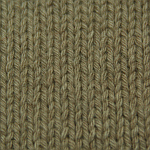 |
Good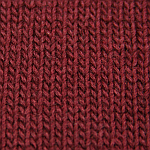 |
Good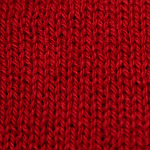 |
| Pill test: Amount of fiber produced by scrubbing the swatch between my knuckles for 1 min. |
Most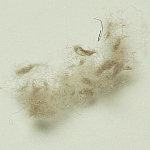
| Least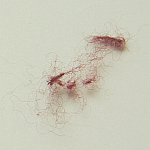
| Medium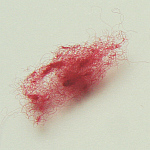
|
| Fabric appearance after pill removal |
Good | Okay but only when cut off with scissors |
Okay but better when cut off with scissors |
They washed well; they pilled differently
All three yarns were soft enough to wear against the skin, and they all coped well with being washed gently.
On the other hand, the amount of fiber produced from the pilling test varied widely. Pilling is affected by factors such as the length of the fibers—the shorter the fiber, the more easily it can make its way to the surface of the yarn—and the yarn's construction—the more twist in the yarn the more tightly the fibers are bound within its core.
Generally, more twist is introduced to a yarn with every ply. So, of the yarns I looked at, the 2-ply Lotus Cashere Fingering has the least twist, next is the Bergère de France Cachemire+ with 5 plies, and the yarn with the most twist is the Jaeger Cashmina with its crepe construction. This yarn is made of 4 super-slim 3-ply yarns which are then all plied together in the opposite direction, which makes for a very high total twist!
A down-side of the longer fibers is that the pills were more firmly anchored in the fabric. While the pills which formed on the Bergère de France swatch pulled off easily, those on the Jaeger Cashmina and the Lotus Cashmere were trapped within the fabric by their longer fibers. Pulling them off left an ugly-looking fabric, but snipping them away with a pair of scissors fixed the problem.
And while these deeply-anchored pills are a bit more of a faff to deal with, I have used the Jaeger Cashmina for a scarf and a sweater in the past and years later, both are still looking good. I would prefer to snip off these long-fibered pills infrequently rather than deal with the numerous—though easily removed—pills that would form on a garment made from a yarn with short fibers.
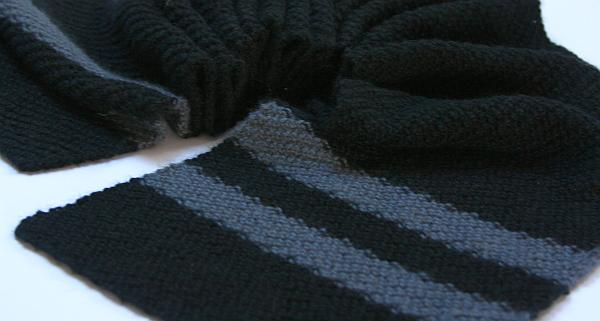
Use the pinch test to estimate fiber length
While I can make a judgment on the amount of twist in a yarn just by looking at its construction, I can't pull it apart to find the length of its fibers without paying for it!
A gentle pinch test tells me what I want to know. By pinching your fingers together on the surface of the yarn, and carefully pulling these fibers away from the body of the skein, you can estimate fiber length without damaging the yarn.
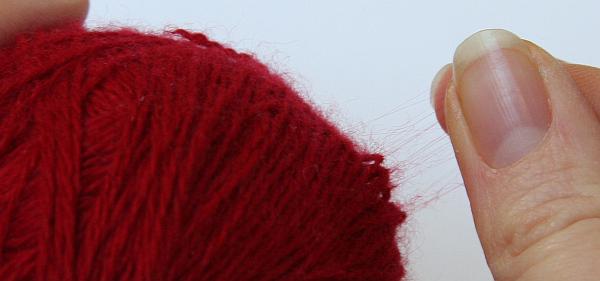
How will I choose cashmere yarns in future?
- Perform a gentle pinch test on the yarn to estimate the length of the fibers. I'll be looking for a yarn with fibers of at least 5 or 6cm (2" or so).
- Look at the yarn construction. The more total twist, the more likely that the fibers will stay in the fabric rather than escape to the surface.
- If I can, I'll buy one skein to swatch, wash and generally try out before taking the decision to buy more. That might seem like an extravagance given the high price of cashmere yarn, but for any multi-skein project, it might be a false economy not to.
Do you have any tips for choosing cashmere? If you'd like to share them, send me a mail to hello@yarnsub.com!
Written by Wendy
Last edited 7 January 2016
